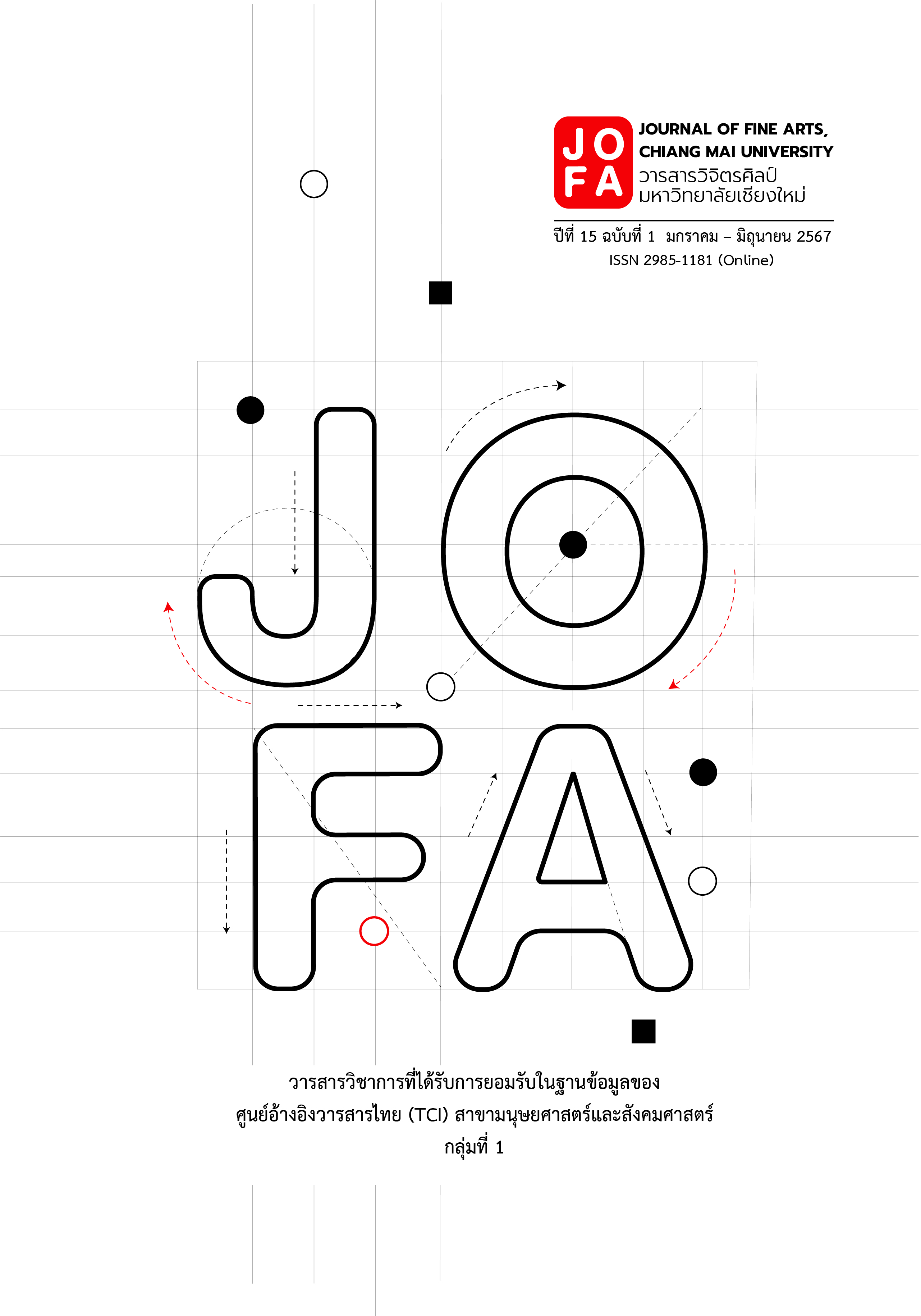Materialism Aesthetics and Space Perception: A Study of Journey to Muang Klaeng Poem
Main Article Content
Abstract
Materialism is one of a school of thought that both Thai and international artists refer to when they need to analyze the spaces in their creative works, such as architecture, visual art, Literature, and design. However, research shows that Thailand’s academic research related to analysis of space through the lens of materialism aesthetics is scarce. This article is an attempt to experiment in reading Thai literature through the lens of materialism to discover new knowledge in space creation. Journey to Muang Klaeng poem, written by Sunthorn Phu, is a sample used in this article. The poem consists of 8 parts divided by chronological order of the journey. Prior to analysis, there’s a literature review including of Karl Marx’s materialism, Jacque Lacan’s objet petit a, Gilles Deleuze’s assemblage, new materialism and posthumanism, East Asian’s philosophy of nature, Indian’s Carvaka (or so-called Lokayata), and Byung-Chul Han’s Shanzhai. Knowledge from literature review was used to generate theme during Framework Analysis method. Results show that materialism spaces in Journey to Muang Klaeng poem share many common characters with materialism in contemporary art world. However, most of the space perceptions by Sunthorn Phu during the journey are based on philosophy of nature. Knowledge from experiment entails conclusion that material aesthetic of spaces found in Thai literature may open possibilities to apply to other art practices.
Article Details

This work is licensed under a Creative Commons Attribution-NonCommercial-NoDerivatives 4.0 International License.
References
Ainsworth, T. (2020, Mar 25). Form Vs. Matter. The Stanford Encyclopedia of Philosophy. https://plato.stanford.edu/entries/form-matter/
Bala, A. (2020). Chinese Organic Materialism and Modern Science Studies: Rethinking Joseph Needham’s Legacy. Cultures of Science, 3(1), 62-74. https://dx.doi.org/10.1177/2096608320911316
Bhattacharya, R. (2011). Studies on the Carvaka/Lokayata. London: Anthem Press.
Carter, R. & McCarthy, E. (2019, November 27). Watsuji Tetsurō. The Stanford Encyclopedia of Philosophy. https://plato.stanford.edu/entries/watsuji-tetsuro/
Deleuze, G. (1994). Difference and Repetition. New York: Columbia University Press.
Deleuze, G. (1997). Cinema 2 : The Time Image. Minneapolis: University of Minnesota.
Eidos84. (2011). Merleau-Ponty - Exploration of the Perceived World: Space (English Subtitles). Youtube. https://www.youtube.com/watch?v=UMy_m1-BRJg&t=40s
Grubernitsch, director.(2020). Slavoj Žižek on Lacan – Objet Petit a Explained Using Pokémon Go. Youtube. https://www.youtube.com/watch?v=b5Spuc1I7RQ
Guyer, P. & Horstmann, R. P. (2021, Februar 5). Idealism. The Stanford Encyclopedia of Philosophy. https://plato.stanford.edu/entries/idealism/
Han, B. C. (2017). Shanzhai: Deconstruction in Chinese. Boston, Massachusetts: The MIT Press.
Han, B. C. [Twitter Post]. (2021, July 2). 9.27 AM. https://twitter.com/Byung_ChulHan/status/1410787174879006727
Harvard GSD. (2013). Arata Isozaki. Youtube. https://www.youtube.com/watch?v=FK3tdABZ5CU
Hausmann, M. (2016). Concrete Reality: The Posthuman Landscapes of J.G. Ballard [PhD dissertation], Chapman University. https://digitalcommons.chapman.edu/english_theses/3/
Interaction Design Foundation. (n.d.). Principles of Interaction Design derived from Merleau-Ponty. Interaction Design Foundation. https://www.interaction-design.org/literature/book/the-encyclopedia-of-human-computer-interaction-2nd-ed/philosophy-of-interaction
Jamieson, J. & Smart, C. (2020, July 28). Materialism. Britannica. https://www.britannica.com/topic/materialism-philosophy
Jobst, M. (2016). Writing Sensation: Deleuze, Literature, Architecture and Virginia Woolf’sthe Waves. The Journal of Architecture, 21(1), 55-67. https://dx.doi.org/10.1080/13602365.2016.1140671
Kirshner, L. (2005). Rethinking Desire: The Objet Petit a in Lacanian Theory. Journal of the American Psychoanalytic Association, 53(1), 83-102. https://dx.doi.org/10.1177/00030651050530010901
Lal, S. (2019). Thresholds of Caste and Nation: Mulk Raj Anand’s Spatial Aesthetics in Untouchable. Journal of Postcolonial Writing, 55(1), 34-47. https://dx.doi.org/10.1080/17449855.2018.1485592
Li Dan. (n.d). The Concept of “Oku” in Japanese and Chinese Traditional Paintings, Gardens and Architecture: A Comparative Study. https://www.hues.kyushu-u.ac.jp/--2022renewal-backups/education/student/pdf/2009/2HE08084E.pdf
Marenko, B. & Van Allen, P. (2016). Animistic Design: How to Reimagine Digital Interaction between the Human and the Nonhuman. Digital Creativity, 27(1), 52-70. https://dx.doi.org/10.1080/14626268.2016.1145127
Mark, J. J. (2020, June 17). Charvaka. World History Encyclopedia. https://www.worldhistory.org/Charvaka/
Maybee, J. E. (2020, October 2). Hegel’s Dialectics. The Stanford Encyclopedia of Philosophy. https://plato.stanford.edu/entries/hegel-dialectics/
Miller, A. (2019, December 13). Realism. The Stanford Encyclopedia of Philosophy. https://plato.stanford.edu/archives/win2019/entries/realism/
Nerdwriter1. (2020). Why Did Ozu Cut to a Vase? [Video]. Youtube. https://www.youtube.com/watch?v=TcfZCCm4eIo
Politakis, C. (2014). The Human Body Matter: Notes on the Persistence of Anthropomorphism in Architecture. Conference proceedings: What’s the Matter? Materiality and Materialism at the Age of Computation. 328-335. https://www.researchgate.net/publication/270273112_The_Human_Body_Matter_Notes_on_the_Persistence_of_Anthropomorphism_in_Architecture
Rollins, P. (2020, July 15). The Object That Doesn’t Exist. Youtube. https://www.youtube.com/watch?v=no-n0E41wqA
Sanzo, K. (2018, April 25). New Materialism(s). Critical Posthumanism. https://criticalposthumanism.net/new-materialisms/
Sonic Acts. (2016, February 27). Louis Henderson: ‘Animism Is the Only Sensible Version of Materialism’. Vimeo. https://vimeo.com/158145401
Sunthorn Phu. (1922). Prachum klō̜n nirāt tāng tāng phāk thī nưng : Sunthorn Phu sī rư̄ang [A collection of travelling poems, part I: Sunthorn Phu’s four travelling poems]. ed. Phrayā wichit wong wutthi krai Krung Thēp Mahā Nakhō̜n . Bangkok: Sophon Printers. https://www.car.chula.ac.th/display7.php?bib=b1292922
Tripp, T. (n.d.). An Outline of Philosophy Materialism versus Idealism. Marxists. https://www.marxists.org/history/australia/1970/philosophy2.htm
Tucker, J. A. (2003). Japanese Views of Nature and the Environment. edited by Helaine Selin. In Nature across Cultures: Views of Nature and the Environment in Non-Western Cultures, 161-183.
Verma, K.D. (2008). The Metaphors of Untouchable and Coolie in Mulk Raj Anand’s Novels Untouchable and Coolie and His Sense of Social Justice. Asiatic, 2(1), 32-46. https://doi.org/10.31436/asiatic.v2i1.362
Voorhees, G. (2016). Materialist Fantasies: The voice of objet petit a in digital games. Journal of Gaming & Virtual Worlds, 8(3), 247-264. DOI: 10.1386/jgvw.8.3.247_1


